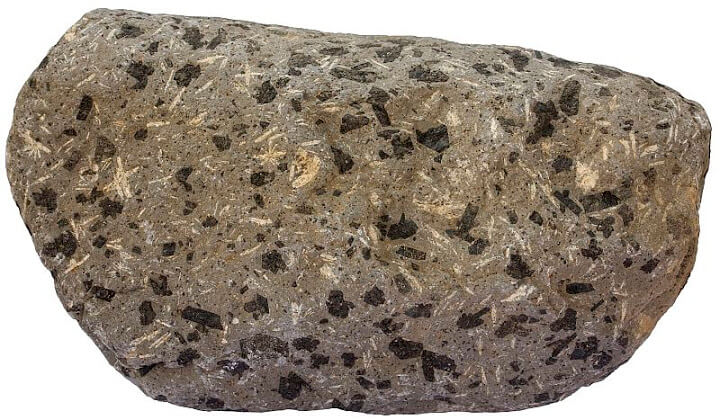Table of Contents
Porphyry. — This name refers to the structure, which is formed of larger crystals set in a fine-grained or glassy ground-mass. The porphyritic structure may be plainly visible, the larger crystals being easily seen (phenocrysts), or it may require the microscope to bring it out. Porphyritic structure may appear in any igneous rock, but the true porphyries are rocks in which there is a marked contrast between the large crystals and the ground mass. The explanation suggested for their origin is that the cooling went on slowly enough at first for the growth of large crystals; but, before the whole mass became solid, some change caused more rapid cooling, perhaps by the pushing up to the surface of a deep cooling mass of magma.
Quartz-porphyry
Quartz-porphyry has phenocrysts of quartz and usually feldspar, in a fine-grained ground mass. The quartz crystals are often rounded and sometimes quite dark, looking like small eyes; hence the name bird’s eye porphyry. When the ground mass is composed of small crystals of feldspar and quartz, the rock is called granite-porphyry. Both are of the composition of granite, and both are found in the elvan dikes of the tin district in Cornwall. Quartz- porphyry is common in the Porcupine gold camp, Ontario.
Feldspar-porphyry
Feldspar-porphyry is characterized by crystals of feldspar in a fine-grained or glassy ground mass; it has the composition of syenite. If the fine-grained part shows under the microscope as crystals of feldspar, hornblende, and mica, the rock is called syenite-porphyry. Both are light-colored rocks, corresponding to syenite. These porphyries are characteristic rocks of the Northern Ontario goldfields. Feldspar porphyry is closely associated with the Kirkland Lake, Ontario, gold ore. A very large proportion of the productive gold mines of the world are found in the near neighborhood of acid porphyries.
Lamprophyre
Lamprophyre, is a dark-coloured, fine-grained rock, with phenocrysts of black mica, hornblende, or pyroxene. It occurs in small dikes and sills, usually accompanied by aplite dikes. Mica-lamprophyre is called minette.
